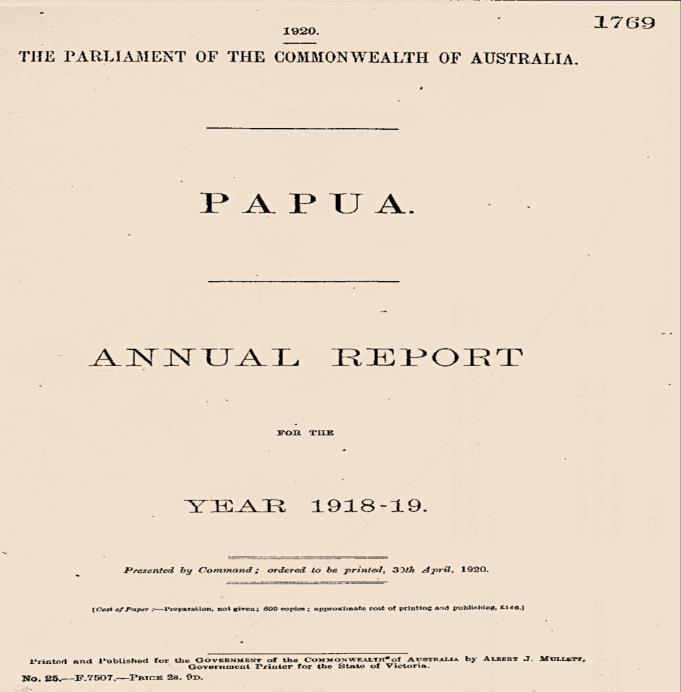
8 minute read
1920 Lack of Wood Preservation Treatments
from PNGAF MAG ISSUE #9J W3 of19th Nov 2022 PNG WOODS Phases of Industrial Development till 1975
by rbmccarthy
1920. Lack of Wood Preservation Treatments26 . Throughout PNG’s history, there were no long-standing timber structures. This was because the sapwood of all PNG timbers and the heartwood of some PNG timbers are liable to attack by wood destroying fungi, boring insects, and termites. In addition, all untreated timber placed in saltwater is liable to attack by a variety of organisms collectively known as marine borers. There was an enormous need to develop wood preservation methods for PNG timbers.
Back in 1920, the problems of a lack of timber preservation treatment were highlighted in the
Advertisement
1918-19 PAPUA Annual Report. 27 Extract. The staff consisted of the Acting Director, Superintendent, Road Engineer, Draughtsman, Acting Accountant, and a temporary Clerk for part of the year, together with a storeman and two or three overseers for varying periods. The Superintendent--Mr. J. MacDonald-returned from vacation leave on the 21st of October 1918. Mr. G. M. Turnbull draughtsman, acted in Mr. MacDonald’s place during the latter's absence, and Mr. Turnbull went on six months' leave on the 23rd of August 1918, returning on 4th March 1919. With regard to the office staff, I have had to be content with an acting accountant, who had no assistance during the greater part of the year, the result being that much of the work got seriously behind and any attempt at keeping correct records and costs of work had to be almost abandoned. I also had to manage with a shortage in the mechanical staff, both these difficulties being due to the reluctance of the Government to fill positions which might at any day be made available to officers returning from the Front. When all the returned men who can reasonably claim positions have been absorbed, it will still remain necessary to find more men for the mechanical staff, as a large amount of maintenance work, which in normal times would be regarded as absolutely essential, has been permitted to stand over, partly owing to the shortage of men, but mainly due to the high cost of materials and the scarcity of shipping. However, the new position will have to be faced, as the general opinion throughout the world appears to be that the tendency during the next few years will be for the cost of both material and labour to increase. For the reasons already stated, the majority of our buildings are falling into a dangerous state of disrepair, so much so that if they are not attended to very soon, they will not be worth repairing. These remarks apply to the buildings at Moresby and Samarai, but much more so to those on outstations, where, in addition to the shortage of labour and the high cost of materials, I have had to contend with the very serious shortage of

26 REF: PNGAF Mag # 9A of 15/3/71 p22 27 Extract of W R Smith’s Acting Director of Public Works, Public Works Department. Annual Report for the year ended 30th June 1919 (pages 67 to 70
local shipping, with the result that an inspecting officer would be occupied for months in going the rounds of all the stations to ascertain what is required. Owing to the very high cost of Australian timbers, and the increased freights charged by the small amount of shipping available, I have endeavoured to get along with timbers supplied by the local sawmills, but the results are very far from satisfactory. The timbers being cut from immature logs and badly milled as well, the result being that a perfectly straight stick is quite an exception, thus involving considerably more labour in the construction of a building than would be necessary when using properly milled timber. I am, therefore, going into the question as to whether it would not pay better to obtain Australian timbers, even at the enhanced prices prevailing. This all leads to the question as to whether it is any longer the best policy to erect wooden buildings, which are all open to the dangers of being attacked by white ants, woodborers, dry rot, and all the other disabilities to which timber is subject in the tropics. I am seriously considering the question of erecting all future permanent buildings with concrete walls.
At the present time, Government offices are scattered all over the town. They are all timber structures, some of them having been erected more than twenty years ago and are now quite inadequate in size to provide for the increasing staff. A proposal to construct one building to contain the whole of the Administrative staff has been discussed, and should this idea be carried out, it would become a great convenience to both the public and the Government staff. At present, much time is lost in getting from one Department to another. New Wharf -As mentioned in my previous annual report, work was suspended in November 1917, pending arrangements being made to obtain expert advice from Australia as to whether the work was being carried out on the best lines. A report was obtained from Mr. Mann on the preservation of timbers in tropical sea waters, and Mr. Hall, of Brisbane, also visited Port Moresby, and made an inspection and report. Subsequently it was arranged that before proceeding further with the work, the advice of Mr. T. Hill, of the Commonwealth Works and Railways Department, should be obtained, but Mr. Hill was apparently never able to visit the Territory, and therefore nothing has been done with the exception of fixing some bollards and fenders. Arrangements are in hand for the erection of a cargo shed, 140 feet by 30 feet, on the shore end of the wharf, and this work will be put in hand immediately, thus very much relieving the congestion which has recently existed. Complaints have been received for a long time from residents at Samarai regarding the inadequacy of wharf and shed accommodation at that port, and as the existing wharf is getting into a state which is almost beyond repair, the question is under consideration as .to whether funds should be made available to grant the facilities demanded. The question of better hospital accommodation for natives, both at Samarai and Port Moresby, has been much discussed, and preliminary schemes have been worked out, but the matter is now .in abeyance pending the return of Dr. Buchanan, C.M.O. and Dr. Giblin, G.M.O., Samarai, from active service.
About 3 acres of land have been reclaimed from low-lying ground at Samarai, ·and arrangements are now in hand to segregate the gaol accommodation, police barracks and native hospitals on this area. The main gaol, head gaoler's cottage, warders' quarters, kitchen, and latrines have already been erected. With regard to the road from Port Moresby to Sapphire Creek, a large copper mine is in course of development at the end of this, and the company is using heavy traction -engines, weighing up to 13 tons, for the transport of their ore to Port Moresby. As it was recognised, both by the Government and the company, that this could only be regarded as extraordinary traffic, an arrangement was come to under which the company undertook to maintain the road during those months of the dry season when they are using it. The company has put in several deviations to reduce curvature and grades, which was done entirely for their own convenience, but is certainly an advantage to the public. I regard the result of the arrangement as entirely satisfactory from both the Government and the public point of view. Arrangements were made to construct a road from the coast at Kapa-Kapa to the KempWelch River, a distance of about 17 miles, to serve some plantations there. About half of this length has been constructed sufficiently well to carry wheeled traffic in the dry season, but a large expenditure in metalling, bridges and culverts will be necessary, to make the road fit to carry wheeled traffic throughout the year. I do not consider that the traffic at present in sight justifies this expenditure. On the high country in the Sogeri District there is some excellent rubber land, where several thousand acres are in bearing, and difficulties of transport are generally recognised as a serious handicap. The Government has recognised for a long time that these difficulties should be remedied, but the mountainous nature of country offers many obstacles to road construction. I have always advised that thorough survey should be made to ensure the best location before any money is expended on construction. This, of course, takes time, but the surveys have now been completed, and I am convinced that the route now pegged is in the correct place though it is not all easy going. A start is to be made immediately on the construction of a good mule track along this route, which can eventually be improved to carry vehicular traffic. Even this, although only a mule track, will be a great boon to the planters, as the existing track contains many almost impossible grades. The water supply of Port Moresby is provided by a corrugated iron catchment, about twothirds of an acre in extent and a reservoir capable of holding 500,000 gallons of water. The water is distributed through the town by a 4-inch 'main, with standpipes 300 or 400 feet apart. The Department delivers water into tanks at the various tenements at a charge of l0s. per 1,000 gallons. With this very limited supply we could not dare to reticulate each household, as we would very soon find ourselves without water even with all the care exercised, we are sometimes on the verge of finding the reservoir entirely exhausted, and it is probable that eventually some better arrangement will have to be made. At a distance of about 20 miles from Port Moresby we have the Rouna Falls, on the Laloki River, at an elevation of some 1 400 feet above sea level, with a flow which would be sufficient to provide a water supply for a city with a of many thousands. It is my intention to go into this question in the near future and submit a proposition and estimate of cost.

